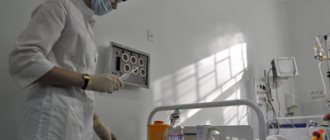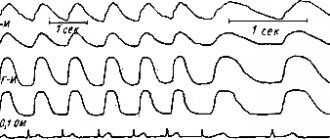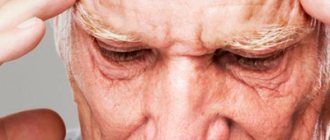Most often, pregnant women experience nausea in the morning on an empty stomach due to intoxication, but it is not uncommon for this problem to occur in men or even children
Don’t worry too much if you’ve encountered this problem once, it’s likely that it’s just a simple poisoning. But, if nausea in the morning on an empty stomach does not go away, you should immediately consult a doctor. Some people are used to coping with this problem with folk remedies and medications and they actually feel better, but it is worth considering that most likely the disease or pathology itself continues to develop. And as a result, it will turn into a more serious form. That is why it is so important to see a doctor who will find out the cause of morning sickness and prescribe the most effective treatment.
Causes of headaches, nausea and weakness
This set of symptoms may appear suddenly or be associated with various external factors. When diagnosing the cause of headache, weakness, nausea and deterioration of health, it is important to indicate to the doctor under what conditions these signs appear, with what intensity and what additional symptoms are accompanied.
Poisoning
Intoxication is one of the first suspicions of a doctor in case of headache, nausea and dizziness. This condition is characterized by the entry of toxins into the body and the response to them. The patient experiences weakness, headache, nausea and vomiting, and increased general body temperature. Toxic substances can enter the body in different ways, and the type of poisoning will depend on this:
- food poisoning - often occurs in the summer, due to perishable foods, and is also associated with the germination of fungal spores in them;
- drug poisoning - the main cause is non-compliance with the dosage;
- alcohol intoxication - the danger is posed by metabolites of ethyl alcohol or methyl alcohol in low-quality alcohol;
- poisoning with pesticides, acids and alkalis, carbon monoxide and other substances that penetrate the skin or with inhaled air.
Treatment for poisoning is selected individually. If there is an antidote (a specific substance that neutralizes the effect of the poison), it is important to take it as quickly as possible. In case of food poisoning, gastric lavage, fasting or a bland diet are prescribed. In some cases, electrolytes are administered by drip to restore blood composition. Intoxication is dangerous if toxic substances penetrate the brain and destroy nerve cells. It is important to seek medical help in a timely manner in order to treat poisoning in a hospital setting.
Infectious diseases
Headache, weakness, fever and nausea are typical symptoms that can occur when viruses or bacteria enter the body. The clinical picture is supplemented by specific symptoms that suggest the causative agent of the infection.
- ARVI, influenza are viral diseases of the upper respiratory tract, which often appear in the cold season and in the off-season. At the next stage, a sore throat, runny nose, cough and wheezing, as well as other specific symptoms, are added. Treatment is symptomatic, aimed at eliminating symptoms and increasing immune defense.
- Rotavirus infection (intestinal flu) is a contagious disease that affects the intestinal mucosa. In the first few days, the patient is worried about fever, headache, nausea and vomiting, and digestive tract dysfunction. In children, the disease manifests itself in an acute form; treatment in a viral hospital is often necessary.
- Meningitis is an inflammation of the lining of the brain. The disease can be viral, bacterial or fungal in origin and causes acute attacks of headache. The condition worsens over time, fainting and a significant increase in temperature are possible. Nausea and vomiting are not associated with meals. Taking analgesics does not bring the desired result. Treatment is complex and only possible in a hospital.
The main condition for recovery is timely seeking medical help. For treatment, antibiotics, supportive medications, painkillers and anti-inflammatory drugs, and infusion of electrolytes are prescribed. After the illness, the patient may be bothered for a long time by acute headaches associated with tension, overwork, physical exertion, or changes in weather conditions.
Migraine
An acute headache that occurs in attacks is called migraine. Its exact cause is unknown, but its origin is associated with vascular or neurological disorders. The disease often affects several family members at the same time, which proves a hereditary predisposition. It can also be triggered by chronic hypertension, atherosclerosis, and circulatory pathologies in the brain.
The headache does not appear suddenly. Initially, a “migraine aura” occurs, which begins several hours before an acute attack. It includes the following symptoms:
- general weakness, dizziness;
- nausea and vomiting;
- increased sensitivity to bright lights and loud noises, resulting in decreased hearing and vision;
- impaired coordination of movements.
Before a headache attack begins, you can reduce its intensity. A neck and head massage and a cool shower help a lot. Painkillers only work against moderate pain. For the treatment of acute migraine, specific drugs are prescribed, which are available by prescription.
Pathologies of the heart and blood vessels
One of the main causes of headaches, weakness and nausea is diseases of the cardiovascular system. Spasms, uneven dilation of blood vessels, problems with blood pressure - these factors impair the supply of oxygen-rich blood to the brain. It is important to understand what disorders caused the headache attack, since they require different treatment tactics, and in the absence of it they can progress.
- Hypertension is high blood pressure. The disease is caused by insufficient elasticity of blood vessels, atherosclerosis and other factors, and often occurs in old age. The patient is recommended to monitor blood pressure at home and regularly take medications to lower it.
- Hypotension is a chronic decrease in blood pressure. The disease can be triggered by heart failure, anemia, and low tone of the vascular walls. It leads to disruption of blood supply to the brain, causes weakness and dizziness, nausea, pallor of the skin and mucous membranes.
- Increased intracranial pressure - this value includes the pressure of all substances on the inner wall of the skull, including blood, the contents of the cerebral ventricles and brain tissue. The diagnosis is made by indirect signs; in case of urgent need, the doctor takes a puncture of the cerebrospinal fluid for additional research - what matters is the pressure with which it flows out.
- Atherosclerosis is a chronic disease of blood vessels, in which deposits and plaques form on their inner wall. One of the reasons remains a violation of fat metabolism and the accumulation of cholesterol. The condition is accompanied by vascular disorders, constant headache, and numbness of the limbs. The disease is dangerous if left untreated, since there is still a possibility of a blood clot breaking off and completely blocking the vessel.
- An aneurysm is a protrusion of the arterial wall, the formation of a pathological pocket. The tissues become thinner, so there is a risk of rupture of the vessel during physical activity, stress and increased pressure. Aneurysm of the cerebral arteries causes acute attacks of headache and dizziness, nausea, vomiting, impaired vision, hearing and coordination of movements.
A sharp headache, which is accompanied by weakness, nausea, and fainting, should be a reason to urgently consult a doctor. These symptoms may signal a stroke - an acute disorder of cerebral circulation. Its causes are either ischemia (insufficient blood supply to certain areas) or rupture of a vessel with the formation of a hematoma. Nerve cells die and cannot transmit impulses. The success of treatment depends on timely provision of medical care, as well as rehabilitation. Initially, it is carried out in a hospital setting, and then continues for a long time at home.
Diseases of the cervical spine
The cervical spine contains important arteries that carry blood to the brain. In some diseases, they are compressed by the vertebrae, which leads to ischemia, headaches and other dangerous manifestations. The diagnosis is made on the basis of X-rays, CT or MRI.
- Osteochondrosis is a common pathology that manifests itself in both elderly and young people. It is associated with insufficient nutrition and blood supply to the intervertebral discs, as a result of which they are gradually destroyed and deformed, losing their elasticity. This leads to a narrowing of the space between adjacent vertebrae, friction of articular surfaces when walking, as well as compression of blood vessels and nerves.
- Intervertebral protrusions and hernias are a dangerous disease in which there is protrusion of the disc on one side. The result is uneven pressure on the cartilage and its abrasion during head movements. The danger is posed by hernias, in which the dense fibrous capsule ruptures and the liquid contents leak out.
- Spinal curvature can also cause severe headaches. Their reason is an uneven load on the neck muscles. On the side on which they are spasmed, they compress important arteries that carry blood to the brain.
If pain, weakness and nausea occur, a diagnosis of the cervical spine is required. Diseases that manifest themselves in this area progress quickly, especially if treatment is not prescribed and physical activity is not dosed. The problem goes away after its root cause is eliminated. However, in advanced cases the joint becomes deformed, and the only solution can be surgical intervention.
Other reasons
Weakness, nausea, headache are symptoms that can accompany various diseases and conditions. They appear in the following cases:
- in women during pregnancy;
- poor nutrition, which results in a deficiency of nutrients, vitamins and microelements;
- chronic diseases of the stomach and intestines;
- disorders of the thyroid gland;
- surges in blood sugar levels.
It is important to understand that even the regular occurrence of these symptoms does not mean that they are within normal limits. They may indicate hidden pathologies that are discovered only with a more detailed examination.
What to do if you feel sick in the morning
It is important to understand that regular morning sickness is a signal of the presence of a pathology or disease and self-medication is highly undesirable. Be sure to consult a doctor for an examination, but if you do not have such an opportunity at the moment, there are several effective ways that will help reduce or temporarily get rid of this problem:
- Medicines. You need to be very careful and you must be sure that morning sickness is not the cause of pregnancy or an intestinal disease.
- Drinks made from ginger root, mint and lemon. You can make infusions of these products for maximum effect by simply adding them to a glass and pouring boiling water, after 15 minutes you will have a very effective and safe (in the absence of allergies) remedy for morning sickness. YOU can also just add them to hot tea.
- Medicinal collection - if nausea persists in the morning, you can try a collection of mint, oak bark and celandine. To prepare the drink, take 1 teaspoon of mint leaves, dried oak bark and crushed celandine, pour 0.5 liters of boiling water and boil in a water bath for 10 minutes. After the broth is cooled and filtered, take 1 tbsp 3-5 times a day before meals.
- During pregnancy. There are little tricks you can use. For example, do not get out of bed quickly, drink plenty of fluids. Eliminate fatty and heavy foods from your diet. Eat small meals several times a day.
Diagnostic methods
At the Clinical Brain Institute, you can undergo a complete diagnosis for frequent headaches, nausea and weakness. It includes several stages, each of which is aimed at detecting different violations. Your doctor may order the following tests:
- general and biochemical blood tests will indicate inflammatory processes, disruption of the functioning of individual organs and systems;
- diagnostics of the cardiovascular system, which includes ultrasound with contrast agent, electrocardiography;
- encephalography - examination of the brain, identification of areas with low levels of bioelectrical activity;
- X-ray of the cervical spine;
- CT, MRI - are used to diagnose brain tissue, blood vessels, and neck joints.
The availability of modern equipment, highly qualified doctors, and the ability to conduct a large number of tests are the main advantages of our center. Based on the data obtained, you can select the most effective treatment that will truly eliminate the cause of the pain.
Treatment methods
The treatment regimen is selected individually for each patient. It includes techniques that will eliminate not only unpleasant symptoms, but also their causes. In the treatment of headaches, which are accompanied by general weakness and nausea, the following techniques can be used:
- drug therapy - the use of painkillers, anti-inflammatory drugs, anti-migraine drugs and specific drugs against various diseases;
- means to improve nutrition and blood supply to the brain;
- if necessary, surgical intervention (for hernias of the cervical spine, aneurysms, neoplasms and other pathologies that cannot be treated conservatively);
- physiotherapy, massage - to improve blood circulation, lymphatic drainage, nutrition of subcutaneous tissues.
Headache, weakness, nausea and other symptoms should be a cause for concern and a full medical examination. It can be completed at the Clinical Institute of the Brain, and you can also receive the most effective prescriptions from specialists of a narrow and broad profile. It is important to take responsibility for your health and seek medical help on time.
Clinical Brain Institute Rating: 4/5 — 5 votes
Share article on social networks
Possible diseases
Most often, morning sickness on an empty stomach may indicate the presence of the following diseases:
- Gastritis (stomach ulcers) is an extremely common disease that can cause not only morning sickness, but also a number of other extremely unpleasant symptoms. This occurs due to inflammatory processes in the duodenum. The patient may also suffer from: burning, bloating during and after meals, heartburn.
- Inflammation of the pancreas (pancreatitis) is also characterized by nausea in the morning, as well as after eating fatty or fried foods. This disease is easily confused with gastritis due to the similarity of symptoms, but with pancreatitis the patient begins to have problems with stool and an unpleasant, bitter taste in the mouth.
- Appendicitis - nausea will most likely fade into the background after unbearable pain in the right side begins to appear.
- Inflammation of the gallbladder (cholecestitis) is a disease that can also be accompanied by morning attacks of nausea. Associated symptoms are pain in the right hypochondrium and excessive gas formation.








